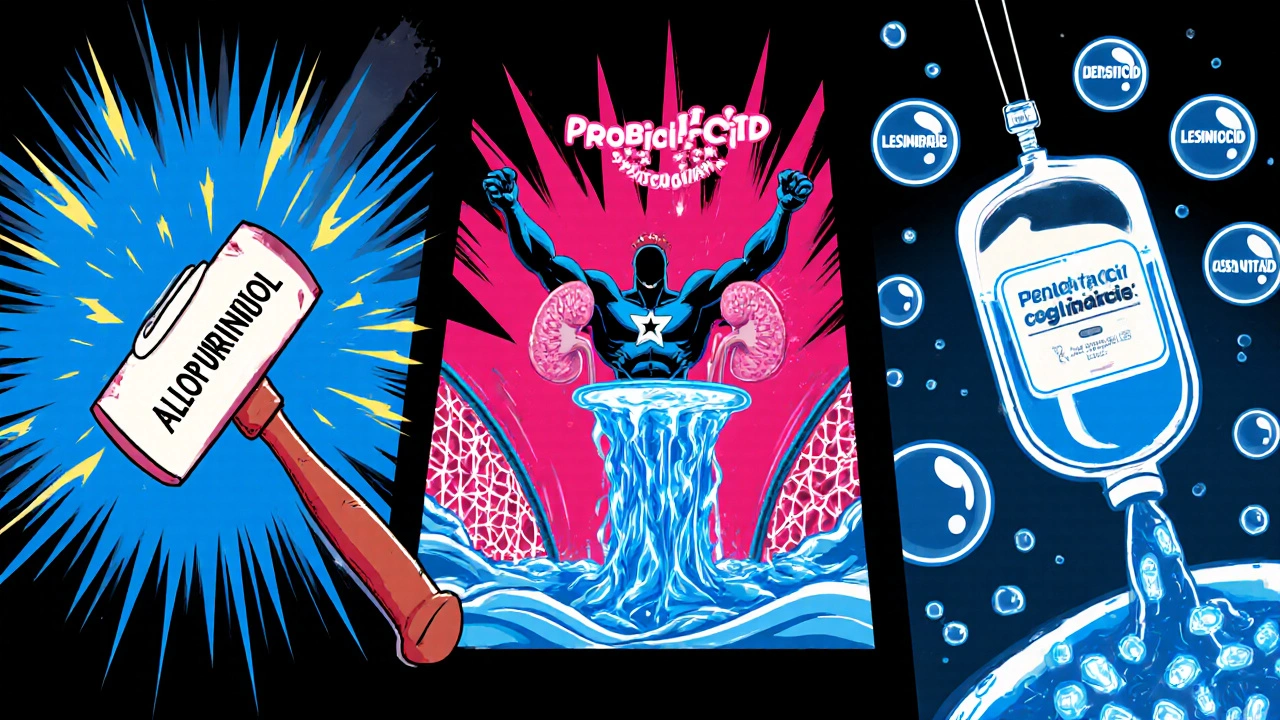Allopurinol vs Alternatives: Gout Medication Comparison Guide

Oct, 15 2025
Gout Medication Decision Guide
Gout Medication Decision Tool
Answer a few questions about your health profile to see which gout medication might be most appropriate for you. This tool is for educational purposes only and does not replace professional medical advice.
Recommended Gout Medication
When it comes to managing gout or chronic high uric acid levels, picking the right pill can feel like a gamble. You’ve probably heard of Allopurinol is a xanthine oxidase inhibitor that lowers uric acid production, but the market now offers several other options. This guide lines up Allopurinol side‑by‑side with its most common alternatives, so you can see which drug fits your health profile, lifestyle, and budget.
Key Takeaways
- Allopurinol blocks uric‑acid production; alternatives either block production, increase excretion, or break down existing uric acid.
- Febuxostat is as effective as Allopurinol for many patients but carries a higher cardiovascular‑risk warning.
- Probenecid works by improving kidney clearance and is ideal for patients with good renal function.
- Lesinurad is used only with a uric‑acid‑lowering drug and helps when uric acid kidneys aren’t excreting enough.
- Pegloticase is a last‑resort IV therapy for refractory gout, but it’s costly and requires close monitoring.
How Allopurinol Works
Allopurinol inhibits the enzyme xanthine oxidase, preventing the conversion of purines into uric acid. The result is a gradual drop in serum uric‑acid levels, usually reaching target values within 2‑4 weeks. Typical adult dosing starts at 100mg daily, titrated up to 300mg or higher based on serum levels and kidney function. Because it reduces production, Allopurinol can be used in patients with any degree of renal impairment-though dose adjustments are needed when eGFR falls below 30mL/min.
Common Alternatives Overview
Below are the four most frequently prescribed alternatives, each with a distinct mechanism.
- Febuxostat is a non‑purine selective xanthine oxidase inhibitor that works similarly to Allopurinol but is more potent at lower doses.
- Probenecid increases renal uric‑acid excretion by blocking reabsorption transporters. It’s a “uricosuric” agent.
- Lesinurad is a selective uric‑acid transporter‑1 (URAT1) inhibitor, used only together with a xanthine oxidase inhibitor.
- Pegloticase is a recombinant uricase enzyme that converts uric acid into allantoin, which is easily excreted. Administered intravenously.

Comparison Table
| Drug | Mechanism | Typical Dose | FDA Approval Year | Common Side Effects | Average US Cost (Monthly) |
|---|---|---|---|---|---|
| Allopurinol | Xanthine oxidase inhibition (production) | 100‑300mg daily (adjust for renal) | 1966 | Rash, liver enzyme rise, rare Stevens‑Johnson | $10‑$20 |
| Febuxostat | Selective xanthine oxidase inhibition (production) | 40‑80mg daily | 2009 | Elevated liver enzymes, cardiovascular events | $150‑$200 |
| Probenecid | Uricosuric - enhances renal excretion | 250‑500mg twice daily | 1951 | Kidney stones, GI upset | $30‑$45 |
| Lesinurad | URAT1 inhibition (excretion boost) | 200mg once daily + xanthine oxidase inhibitor | 2015 | Kidney injury, rash | $250‑$300 |
| Pegloticase | Uricase enzyme - breaks down uric acid | 8U IV biweekly | 2010 | Infusion reactions, gout flares | $2,500‑$3,500 |
Decision Criteria - Which Drug Fits You?
Choosing the right therapy isn’t just about price. Consider these factors:
- Kidney function. If eGFR < 30mL/min, Allopurinol (dose‑adjusted) or Febuxostat are safer than uricosurics.
- Cardiovascular risk. Febuxostat carries a boxed warning for heart disease; patients with a history of MI or stroke may stay with Allopurinol.
- Previous drug tolerance. Rash or hypersensitivity to Allopurinol pushes you toward a different class.
- Uric‑acid target speed. Pegloticase can drop levels dramatically (90% reduction) - useful for severe tophaceous gout.
- Cost & insurance coverage. Generic Allopurinol remains the cheapest; newer agents often need prior authorizations.
Ask your clinician to run a baseline serum uric‑acid test, check kidney labs, and discuss any heart conditions before locking in a drug.
Practical Tips for Safe Use
- Start low and titrate slowly - especially with Allopurinol - to avoid acute gout flares.
- Stay hydrated (2‑3L/day) to help uric‑acid clearance, especially on uricosurics.
- Schedule regular liver‑function tests for Febuxostat and Allopurinol.
- If you’re on Lesinurad, never take it alone; it must be paired with a xanthine oxidase inhibitor.
- For Pegloticase, plan for pre‑infusion antihistamines and watch for infusion‑site reactions.
Monitor serum uric acid every 2‑4 weeks after starting or changing dose; aim for <6mg/dL (or <5mg/dL if tophi are present).
Frequently Asked Questions
Can I switch from Allopurinol to Febuxostat safely?
Yes, but a wash‑out period of 1‑2 weeks is recommended to avoid overlapping xanthine oxidase inhibition, which can trigger a flare. Your doctor will check liver enzymes before the switch.
Why would a doctor prescribe Probenecid instead of Allopurinol?
Probenecid is useful when a patient cannot tolerate Allopurinol’s skin reactions or when kidney function is good enough to handle increased uric‑acid excretion. It’s also cheaper than newer agents.
Is Lesinurad effective on its own?
No. Lesinurad is only approved in combination with Allopurinol or Febuxostat. Alone, it does not lower serum uric acid enough for most patients.
What are the warning signs of a serious reaction to Allopurinol?
Look for a spreading rash, blistering, fever, or sore throat - signs of Stevens‑Johnson syndrome. Seek medical help immediately if these appear.
How often should I have my uric‑acid level checked?
After starting or adjusting therapy, test every 2-4 weeks until you reach target, then every 3-6 months for long‑term maintenance.
Bottom Line
Allopurinol remains the workhorse for gout, but alternatives like Allopurinol alternatives provide options when kidney issues, side‑effects, or cardiovascular risk tip the scale. By weighing mechanism, safety profile, kidney function, and cost, you can partner with your doctor to land on a regimen that keeps uric acid down and flares at bay.
